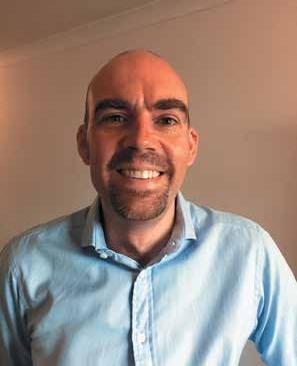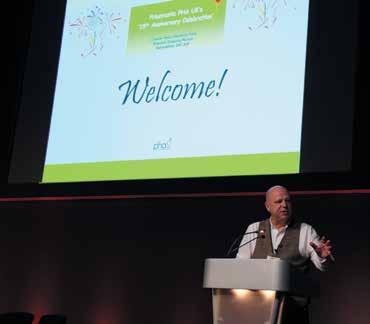
6 minute read
The PHA Interview
from Emphasis Winter 2015
by PHA UK
theinterview
Professor PAUL CORRIS
in conversation with Deborah Wain
Professor Paul Corris, based in Newcastle, is a leading physician in the field of heart and lung transplantation and holds many eminent positions. He is Professor of Thoracic Medicine for the Institute of Cellular Medicine at the University of Newcastle and the Regional Cardiothoracic Centre at Newcastle’s Freeman Hospital. In addition, he is Director of Cardiopulmonary Transplantation and the Northern Pulmonary Vascular Unit in Newcastle. Over the last three years, the Freeman has performed more cardiopulmonary transplants than anywhere else in the UK and is widely regarded as the premier lung transplant service in the country. Paul’s other roles include academic lead and deputy chairman of the Institute of Transplantation. Paul is also a past president of the International Society for Heart and Lung Transplantation and vice president and president elect of the British Thoracic Society. He sits on the Councils of the British Thoracic Society and British Lung Foundation. Paul is a past president of the UK Pulmonary Hypertension Physicians Group and also sits on the Medical Advisory Council of PHA UK. Paul spoke on the subject of future therapies at the PHA UK conference.
Q. Briefly, how did you get to where you are? A. Interesting! I would probably have been the person voted in my year at medical school least likely to have become a professor because I spent too much time playing rugby and partying. However, I always had confidence and once I qualified I concentrated on learning and was always inquisitive. I like thinking outside the box. I studied in London, Leicester, and Newcastle before my first consultant appointment in 1986. I was inspired by many. I spent a year on sabbatical as visiting Professor at McGill University Montreal Canada, in 1994-1995, and returned to Newcastle achieving a full professorship in 2000. I hold visiting professorships in Australia and Italy. I followed leadership advice from Sir Ernest Shackleton.
Q. How many patients attend the Newcastle PH service? A. The Newcastle service is comprised of a hub at Freeman Hospital in Newcastle with spokes to satellite centres in Hull and Belfast. Clinics are held weekly in Newcastle and Belfast and monthly in Hull. On average the service will see four to five new patients each week and approximately 600 patients are currently followed.
Q. How do the Newcastle PH service and transplant service interact? A. There are very close relationships because three of the physicians are appointed to work in both services. This means that patients with PH attending the Newcastle centre get seamless referral to the Transplant Service when necessary. I should point out that referrals for transplantation from other centres are promptly dealt with and patients from Scotland and Northern Ireland may be seen in satellite transplant clinics in Edinburgh, Glasgow or Belfast to facilitate assessment because the patient will always be at the centre of what we do.
Q. When was the first PH patient transplanted in Newcastle? A. That is an easy question because the patient and transplant are so memorable. The patient, a young boy came from Aberdeen and had complex congenital heart disease. It was 1989 and there were no targeted PH therapies available. He had a heart-lung transplant and is still alive and well today 26 years later! I just saw him recently in clinic. He was very ill during the first month post transplantation with a severe infection and I had little sleep for days when looking after him. It was worth the loss of sleep! We started our lung transplant program in Newcastle in 1987 and performed the first successful single lung transplant in Europe. I am probably the longest serving lung transplant physician in the world just now but still have much to learn.
Q. Can you tell us a bit more about a patient’s journey to transplantation? A. It can be long, arduous and a bit frightening but we try to make it smooth. Generally we would receive a referral from a colleague when the patient had reached a point when referral was advised from published international guideline, which I played a role in writing. We would review the letter and if there were pieces of information missing write back for this. With all >>>
theinterview Professor PAUL CORRIS
the information either originally supplied or received we would generally either offer a patient an outpatient appointment to discuss further or, if everything looked as if transplant was possible and necessary, a direct four day assessment admission. Some patients may have contraindications clear from the referral letter and would be turned down at that point. Patients ultimately admitted for assessment might be accepted in principle but regarded as too well at that time to be listed. Others would be listed immediately. A few patients may have contraindications found at inpatient assessment and be turned down. A few patients decide that they do not want to undergo transplantation at this final assessment. Patients listed must then wait until donor lungs become available and this can be a very stressful period of time for obvious reasons. There has been much research and innovation leading to new ways of bridging highly selected patients with PH to transplantation who become very sick whilst waiting, though sadly some patients will not survive the wait. When suitable donor organs are available and transplantation becomes a reality for the majority, patients can expect to be in hospital for a month before return home cured of PH. Yippee!!
Q. What do you consider your best achievement to date? A. No question. Successfully bringing up a family in a loving environment with my wife over 35 years of wedded bliss, despite the stresses and strains of my career is number one. I’m a very recent grandfather to Lilia Rose - 8 lb, 3 oz of sheer magic! Professionally, I’d say my efforts to improve the outcomes of patients following lung transplantation and patients with PH including a major role in developing national services for both will be my legacy, as will the numerous excellent fellows that it has been my privilege to train. Q. You talked about future therapies at the PHA UK conference. What developments are around the corner? A. The physician scientists and basic scientists continue to work hard to find new treatments and new ways of using existing drugs. The pharmaceutical industry also has many new potentially useful drugs in the pipeline. Early use of triple combination therapy has in a preliminary trial been shown to result in very good responses and a full trial is currently planned. For many patients treatment with prostaglandin therapy is not possible because of the method of delivery but a new oral prostacyclin agonist drug called Selexipag has just been shown to be effective and will allow many more patients to be treated. Drugs based on improving the functionality of a receptor called BMPR2 which is often defective in patients with PAH are available and trials ongoing. Inflammation may play an important role in disease progression in PAH and a new UK based trial of an anti-inflammatory drug will soon commence. Translational research, or research leading to direct patient benefit in PAH, is very active at present and greatly enhanced by the collaborative research spirit in the UK. Together we are striving for success. Finally stem cell therapy research continues and the PHA has recently produced a very useful patient guide written by Dan Reed. Q. And finally, how would you describe yourself in three words? A. That’s impossible, but here goes…’magnanimous, not mean’, ‘edgy but not moody’, ‘fun-loving and effective but not magnificent’. I’m failing the three words! .










